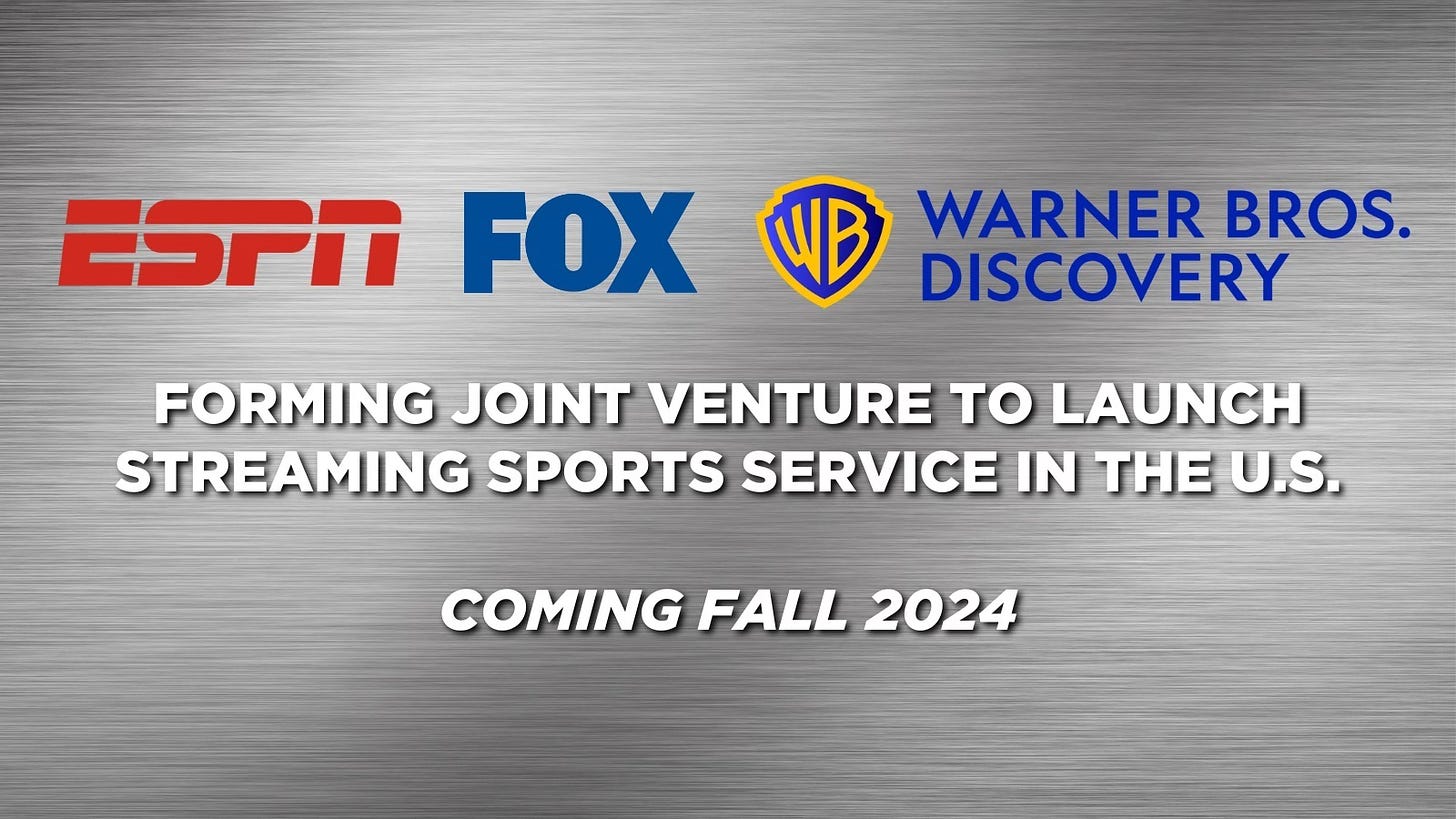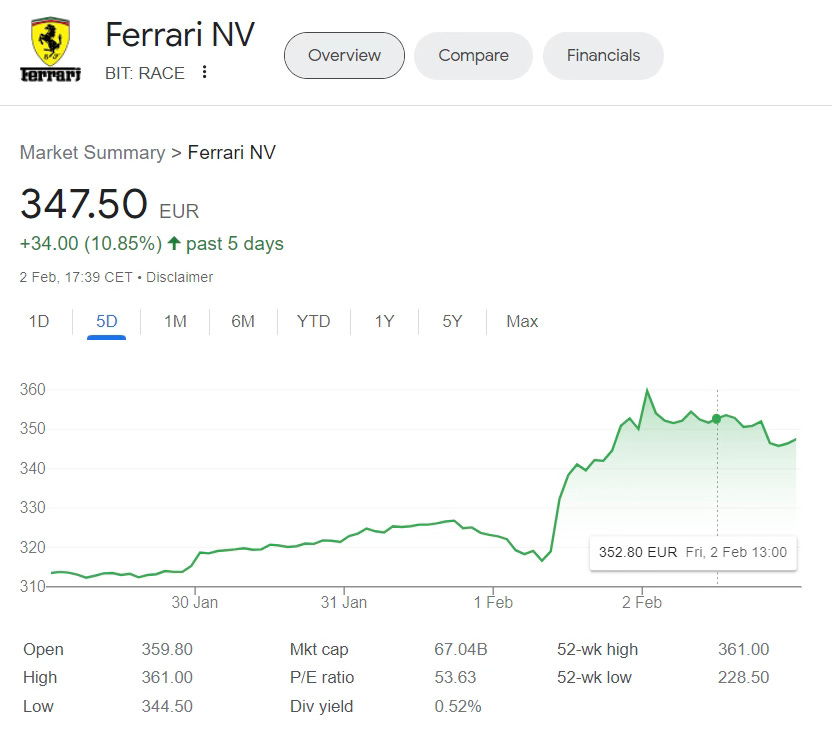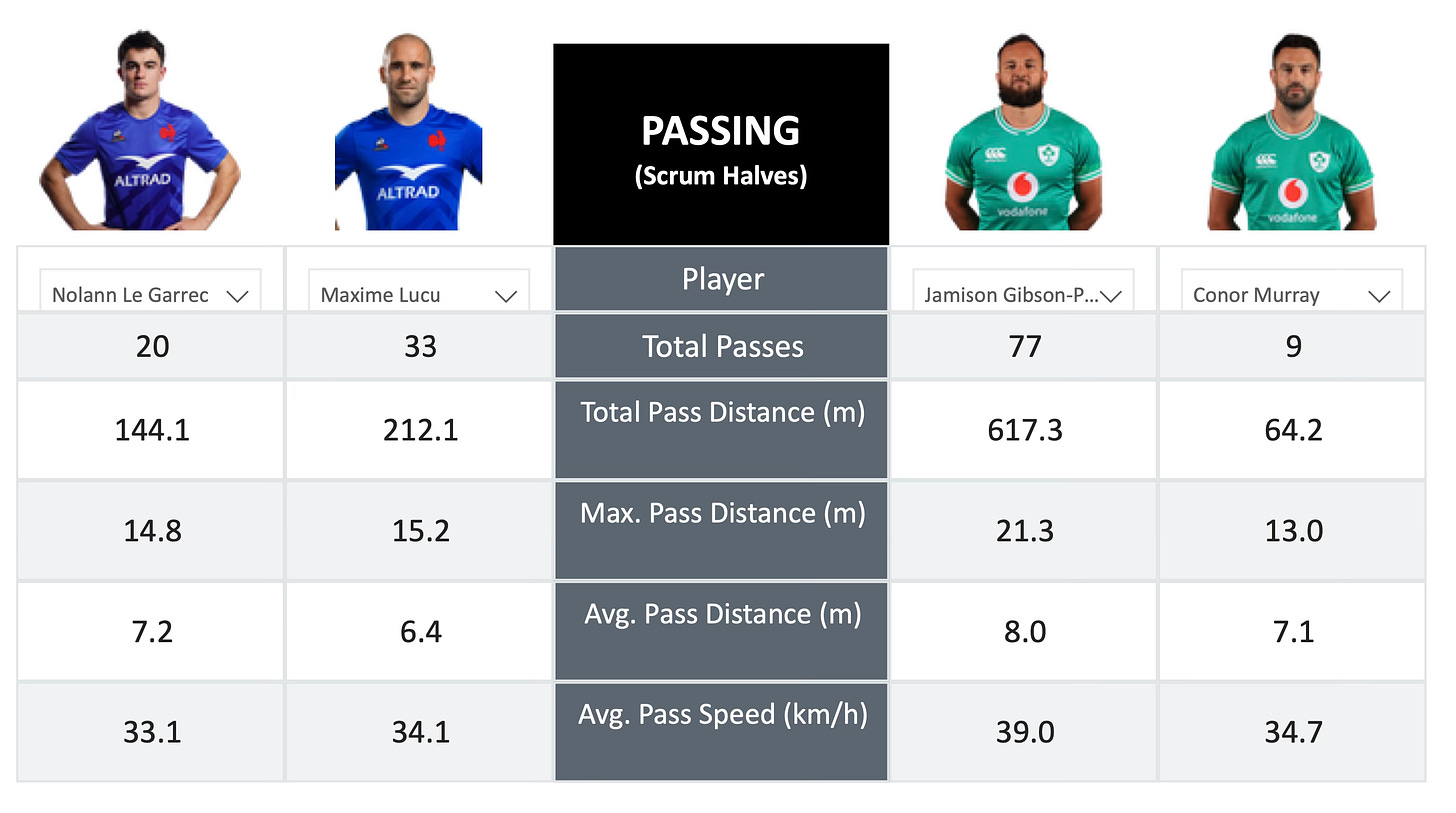Paolo's TMT Picks Gazzetta - Feb 7, 2024: Major US Broadcasters to Combine on New Streaming Service
This week analysis on: ESPN, FOX and Warner Bros. Discovery's new sports streaming service; Super Bowl LVIII; Lewis Hamilton's move to Ferrari; and innovations at the Six Nations rugby.
Welcome to Paolo's TMT Picks
Following the launch of the first of my Gazzettas last week, the stories for this one took on a decidedly sporting flavour. Therefore, and with the Super Bowl coming up this weekend, I decided to keep this Gazzetta free to all comers as well to highlight the breadth of coverage I will be covering. Subscribe below to make sure you don’t miss out on my thoughts and strategic insights as the year progresses. Game on!
ESPN, FOX and Warner Bros. Discovery Combine to Launch Streaming Sports Service in US
News that ESPN, FOX and Warner Bros. Discovery have formed a joint venture “to develop, launch and operate a streaming sports bundle of linear networks and certain DTC sports content and services” is a major disruptive play in the US market.
Each company will own one-third of the new joint venture, have equal board representation, and license their sports content to the joint venture on a non-exclusive basis. The service will also have a new brand with an independent management team. There are no details as yet on revenue share.
The service is slated to launch in fall 2024 and will include sports linear networks and the Direct-to-Consumer Service ESPN+. Given the companies involved, the breadth of sports to be distributed via the newly created app is pretty huge and covers NFL, NBA, WNBA, MLB, NHL, NASCAR, College Sports, UFC, PGA TOUR Golf, Grand Slam Tennis, the FIFA World Cup, some major cycling events, F1, and more.
There are no details on pricing yet. Expect around $50 with promos and discounts to be a reasonable price. Subscribers would also have the ability to bundle the product with other services such as Disney+, Hulu and/or Max.
Given the complex nature of the sports landscape and the parties involved, unsurprisingly the companies are still finalising details. This begs the question: why not wait and announce the deal when everything is confirmed? This has many moving parts, from tech development to managing ad inventory, data analysis and more. Hence, it looks like moving early now is a tactic to generate maximum awareness when the US is fixated on all things sports during Super Bowl week. Conceivably, it might also put pressure on other streamers and right holders to come on board to build an even more all-encompassing offering.
The omission of some major players is notable, and it doesn't include NBCUniversal and Paramount. NBC has Sunday Night Football NFL rights, college rights, and the Olympics, while Paramount’s CBS Sports has Sunday afternoon NFL games, live soccer, and other college rights.
This will be the first time Fox’s live sports are available in a streaming offering. And it’s worth noting that Disney still plans to bring its own broader streaming service to market for ESPN.
This feels like a slightly defensive move that reflects the ever-changing world of the US TV landscape and the massive shift towards streaming. Netflix, Amazon, and Apple are all showing increasing interest in sporting properties, and users’ behavioural patterns are changing rapidly, forcing traditional providers and rivals to react, partner, and evolve quickly in turn.
For many, aggregation is the holy grail, and it is evident that we are returning to the big bundle being offered via the Internet. This has the noted benefit of being a far simpler model for the consumer to understand. Consumers have had enough of signing up for multiple services, paying for different subscriptions, and downloading a slew of apps.
This is especially true in sports, which is one of the few genres driving sign-ups. While competition seems to be healthy, the battle for rights and subscribers is leading to a hugely fragmented landscape. Many companies have made huge gambles, which will take many years to come to fruition, let alone think about making a profit.
Deals such as this represent one of the key routes available to providers to reduce fragmentation, reduce risk, and take greater control. There is a huge focus in the US industry on cutting costs and driving greater efficiencies to improve margins for the year ahead. We can expect more bumps ahead. We can also expect other companies and markets to follow developments closely with a view of replicating it in other territories should it prove to be successful.
Super Bowl LVIII: America’s Most Watched Sporting Event Looks To Scale New Heights
The US’s biggest sporting event occurs on Sunday when the San Fransisco 49ers and Kansas City Chiefs battle on the pitch at the Las Vegas Allegiant Stadium. As well as there being a lot at stake on the pitch, there is a lot at stake behind the scenes.
The Super Bowl attracts the US tech giants to showcase the power of connectivity and to share their stories. They do this via the hugely expensive advertising slots that host broadcaster CBS will run throughout the broadcast and by highlighting their role in supporting the event.
The war of connectivity
Building upon its close partnership with the NFL as the official 5G partner, Verizon’s network will play a crucial role in Super Bowl LVIII. The US telco provides all network communication for the Verizon NFL Media Center (including Radio Row) and coach-to-coach communications on the field during the game.
Having experienced it at previous trade shows, the latter is particularly interesting as it relies on a private network to ensure reliable and robust connectivity in a packed sporting venue.
The Super Bowl will further demonstrate the power of its 5G UltraWideband mmWave network in Las Vegas. On recent visits to the US, I’ve been impressed with the lightning speeds, even more so at high-capacity sporting events such as the inaugural Miami F1 and Las Vegas F1 GPs. From the speed tests I conducted there, I was able to experience network speeds in excess of 4Gbps in Las Vegas and 3Gbps in Miami.
In addition, Verizon is planning a four-day activation bonanza dubbed Verizon Live at Super Bowl LVIII, in collaboration with partners including Netflix, Max and Apple Music (who is also sponsoring the halftime show featuring Usher). The company will also return to the Super Bowl with in-game ads airing on both CBS and Univision.
Having been a key sponsor of the inaugural F1 race in November, T-Mobile has been boosting network capacity in Las Vegas. Now, ahead of the big game, further enhancements inside the Allegiant Stadium include:
62 iDAS (distributed antennae system) sectors inside the stadium, with three sectors covering the field. These cover the entire stadium with Ultra Capacity 5G
Seven oDAS sectors servicing areas just outside the stadium for better coverage of fan celebrations
mmWave enhancements both inside and outside the stadium, so fans on T-Mobile’s network can quickly update their social feeds and friends and family on the latest plays with the fastest possible 5G speeds
Temporary enhancements at specific locations include:
Bellagio Fountains to support users looking to catch a glimpse of the broadcast stage
Mandalay Bay Parking Garage to better support tailgaters at Allegiant Stadium
Wynn Parking Garage for enhanced coverage supporting activities around the Sphere
Brooklyn Bowl enhancements to improve the network experience at the NFL House hospitality zone
The world’s most expensive ad slots
The only thing bigger than the game itself are the ads and the millions of dollars they attract for half a minute of TV coverage. For many consumer brands, it is a worthy investment of time and cash as it is one of the most watched sporting events in the world, transcending geography, socio-economic strata, and demographic cohorts.
Well in excess of 100 million people are predicted to watch the game live in the US alone. However, against a backdrop of an ongoing cost of living crisis, macroeconomic uncertainty, and the shadow of geopolitical conflict, brands do need to be wary. The Super Bowl ads are scrutinised like no other, and the production values must be correspondingly high. This all costs, so those that can part with the hefty price tag are already making good use of their spend by releasing teasers ahead of Sunday’s spectacle and its accompanying hours of coverage.
The list of brands that are taking part this year is already a long one and includes:
betMGM, Booking.com, Bounty, Bud Light, Budweiser, Coors Lite, Doordash, Doritos, Drumstick, E.l.f. Beauty, Etsy, FanDuel, Frito-Lay, Google, Hellmann’s Mayonnaise, Kawasaki, Kia America, Michelob Ultra, Miller Lite, M&Ms, Nerds Candy, NFL, NYX Professional Makeup, Oikos, Oreo, Peta, Popeyes, Pringles, Reese’s, Silk, Starry, Stōk Cold Brew, Squarespace, Toyota, Uber Eats, and Volkswagen.
There are some noticeable omissions there. Some that have decided not to participate this year include the big Detroit carmakers Ford Motor, General Motors and Stellantis, as well as GoDaddy and State Farm.
TV and streaming
Finally, this is also a landmark broadcast in that it is the first Super Bowl to air in 1080p HDR and 4K HDR. CBS is deploying 165 cameras in the Allegiant Stadium and around Las Vegas, including specialist units and the new ‘doink’ cameras that will be positioned in the uprights. With these, it is planning on producing a massive 115 hours of combined coverage of the event from its central broadcast location at Bellagio. The live broadcast will be available on CBS and Nickelodeon (see below) and live-streamed on Paramount+ and NFL+. For the complete list of international rights holders, see here.
Twenty-three of these cameras are augmented reality units: 11 on the main broadcast, four on The Strip, and eight for Nickelodeon. The last is particularly interesting as one of the year's big innovations is a concurrent broadcast aimed directly at kids. CBS says that Super Bowl LVIII Live from Bikini Bottom will feature SpongeBob SquarePants and friends as they help play-by-play announcer Noah Eagle and analyst Nate Burleson call the game. There will also be special appearances from other Nickelodeon stars, such as the Teenage Mutant Ninja Turtles.
We are seeing broadcasters worldwide attempt to further engage the youth demographic in sports, hoping to ensure a future audience for increasingly lengthy rights deals. The Nickelodeon broadcast is one of the most well-resourced and ambitious efforts yet, and it will be interesting to see the impact it has on the planned broadcasting of future sports events in the US and beyond.
The same could be said for everything surrounding Super Bowl LVIII, which looks set to be an enormous spectacle that could set a new benchmark of viewing records for America’s major sporting event. This is especially true when you add Kansas City Chief tight end Travis Kelce’s girlfriend into the equation, a certain Taylor Swift. It would be no surprise if at least one of those 165 cameras (The TaylorCam? The SwiftCam?) was trained on her throughout, and the undoubted star power she will bring to the broadcast could even see it top the 114.4 million viewers record of Super Bowl XLIX in 2015.
Lewis Hamilton’s F1 Move to Ferrari Highlights Power of Sporting Stars to Brands
Formula One (F1) traditionally has a ‘silly season’ over the summer when racing takes a break and speculation mounts as to who will be driving for what team next season. All that has already been blown out of the water this year following the shock news last week that Mercedes AMG Petronas F1 Team driver Lewis Hamilton will be leaving the team after 11 years and driving for rivals Ferrari from 2025.
The news highlighted the importance that major sporting stars can have to brands. Ferrari’s share price soared more than 10% to hit a new record high on the New York Stock Exchange after the announcement, adding nearly $7bn to its market capitalisation (though this was also aided by a strong earnings report released earlier in the day).
The famous Italian marque will be hoping for even more from the rumoured €80m+ salary it is paying to Hamilton, too. Ferrari has been in the doldrums for years. It last won a drivers championship in 2007, it last won a constructors championship in 2008, and, in at least two seasons since then, it has had the best car but come away with nothing as more agile, flexible, and innovative competitors have beaten it to the checkered flag.
It will be looking to convert Hamilton's experience and undoubted skill into results, especially as in 2026, major rule changes will level the playing field for the 10 F1 teams. By embedding Hamilton into the team a year before that happens, it will hope to have a smoothly functioning and world championship contesting team in place and ready to hit the world’s race tracks at full speed as soon as the new spec 2026 cars are unveiled.
Hamilton is a major brand in himself, and as well as maximising prospects for fan engagement across a range of social platforms, the tie-up represents a considerable revenue opportunity for Ferrari. Hamilton and Mercedes were able to attract sizeable investment in terms of sponsorship and marketing opportunities during their long association. Only last year, Qualcomm came on board as a sponsor, and WhatsApp (Meta) was added to the roster with some fanfare at the Las Vegas GP in November. Ferrari will look to leverage Hamilton’s star appeal and lock similar deals in place as a result of his joining (though it has to be pointed out that most sponsorship contracts in F1 are tied to a team rather than an individual driver).
Conversely, it also leaves a significant dent in the ambitions of Mercedes F1 just as the integration of more camera angles, more data, and more overlays in television coverage works to create a far more engaging and social experience. This is opening up a wealth of new opportunities in terms of how the sport, the teams, and brands engage with fans.
How will the tech giants and other sponsors react to the move? Mercedes has been on the back foot in the past two years after taking an innovative but fundamentally flawed approach to its recent chassis designs. It has not delivered the results on the race track. Sponsors who expect to be at the front of the grid and gaining maximum television exposure as a result may start to re-examine their investments. And, as we’ve seen repeated many times over the years, the virtuous circle between delivering on performance and sponsor revenues can turn into a vicious circle with dizzying speed, resulting in fleeing sponsors and back-of-the-grid results.
On the track itself, there is a whole range of different things that may happen. Mercedes may break their hoodoo this season and produce a car that can compete with the field-leading Oracle Red Bull Racing cars, in which case Hamilton may be ruefully leaving a team that is back to their best once more. Or next year’s Ferrari — and the 2026 challenger after it — might follow the recent Maranello trend of unfulfilled promise further undermined by woeful race strategy. The last two really big-name transfers to Ferrari, Fernando Alonso and Sebastian Vettel, both never won a championship with the team.
Either way one thing is certain: this is absolute box office. The nailed-on winners here are Formula One itself, the rights holders worldwide, and Netflix, whose star-studded Drive To Survive documentary series on F1 is about to drop its sixth season on February 23. Away from its core fanatical fanbase, F1 had been perceived as being a bit stale of late: the Oracle Red Bull Racing car of Max Verstappen has dominated the past two seasons, and there has not been a single change in the driver line-up between 2023 and 2024. Hamilton’s move to Ferrari changes everything, and even though it is not happening for another year yet, it will drive the narrative of the entire 2024 season both on the track and in the boardrooms.
Six Nations Innovations Highlight Rugby’s Growth
The latest in the series of Netflix’s sports documentaries is Six Nations: Full Contact, released ahead of last weekend’s first games of the 2024 tournament. Granting Netflix film crews access to the Six Nations teams and players during last year’s tournament is part of a move by the world’s rugby union authorities to widen the game’s appeal. According to some of the figures from last year’s Rugby World Cup in France, it seems to be proving successful in this mission.
RWC France achieved 1.33bn viewing hours across all programming on linear and non-linear broadcast, making it the most viewed rugby event of all time
France 2023 achieved 30% more viewership than England 2015 and 19% more than Japan 2019
Growing viewership was observed across most markets, including rugby’s emerging territories such as Germany and the USA
RWC France 2023 global viewership came at 85% from free-to-air TV, underscoring World Rugby’s mission to make the tournament accessible for all
Streaming services are growing and now account for 5% of global viewership. RugbyPass TV is providing D2C coverage in markets without a local broadcaster
This all echoes wider moves within the game’s governing bodies to address the often fragmented nature of the sport which has held it back on the world stage. There is a new global calendar that better defines club and international time windows, a new Nations Cup competition which cements the partnership between Northern and Southern Hemisphere, and the return of A internationals to give emerging teams better fixtures and a path to the top table over time.
The Six Nations hopes to build on all this, and on the pitch got off to a cracking start with three superb games of international rugby that were each compelling for different reasons. And, to widen its appeal even further, it is embarking on a strategy that can be characterised as leveraging TikTok and technology to reach new audiences.
First, TikTok.
In TikTok, the #SixNationsRugby hashtag currently stands at over nine billion views, and the official @sixnationsrugby channel has reached over half a million followers. The #womensrugby TikTok hashtag. Meanwhile, it has over 900m views, with 159,000 followers of the @womenssixnations TikTok channel and 2.3m likes so far.
A new deal between Six Nations and TikTok was announced in January 2024 to become Official Fans of the Guinness Men’s and Women’s Six Nations Championships. The partnership will also raise awareness of TikTok’s online safety features through its #SwipeOutHate campaign. The new deal captures everything from match highlights and training clips to fan reactions and creator videos, which will be available via TikTok’s official #SixNationsRugby Search Hub.
Seeing a sport such as rugby engaging with new audiences with such fervour is impressive. The women’s game is building momentum month after month, and there is an increasing appetite for the sport amongst the Tier 2 nations, with teams such as Portugal, Japan, Samoa and Georgia helping to widen the game’s geographic appeal. Building these audiences on TikTok is a sensible and targeted way of ensuring that a new generation of players and spectators engage with the game.
The second strand is technology, specifically broadcast technology.
There is an old joke along the lines of ‘I went to watch a fight, and a game of rugby broke out’. But for all its thundering contacts and brute physicality, it is a fearsomely complicated game of many rules. Even seasoned spectators can sometimes find it difficult to understand the totality of what is going on. If rugby is to embrace and engage new audiences, there needs to be a way of bringing the casual viewer along for the full 80-minute ride.
The Six Nations broadcasters are doing a good job of explaining what is going on using screen real estate. Some of this is reflecting new innovations in the game. There is a new strict time limit in which the kicker can attempt a penalty or conversion nowadays, for instance, and an on-screen shot clock counts this down. And referees can now ask the Television Match Officials to review yellow cards using the so-called ‘bunker system’ to see if they should be upgraded to red or not. The card, review, and verdict are all clearly indicated on screen.
The 2024 tournament also sees the return of the Ref Cam, a body mounted system which shows the actions from the referee’s point of view. This is an excellent assist to coverage of the scrum, which even the Camera 2 position often fails to zoom in on in enough detail. The system has been significantly evolved to become more lightweight and comfortable to wear. Audio is important too, and while it can sometimes depend on the TV match director’s whim, it is often good to hear the constant communication between the referee, his assistants, and the video review team underpinning the commentary.
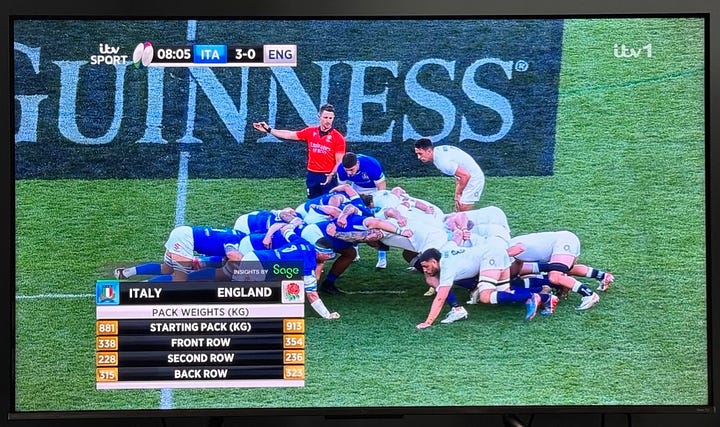

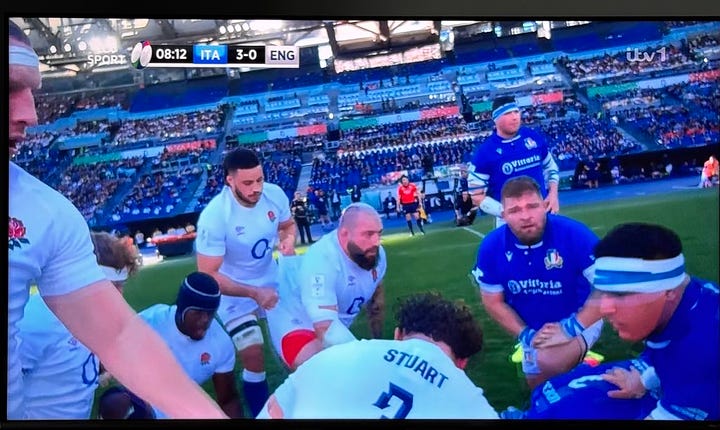

Finally, we have innovations such as Sportable’s Smart Ball, which is tracked in 3D and provides real-time data on the ball’s on-pitch movement that can power a comprehensive suite of Stats Perform data available to the commentary teams and for graphics.
I saw a version of this in development two years ago when it was part of the 5G Edge XR project led by EE, BT Sport & BT Applied Research in collaboration with numerous partners, and it is impressive to see it now part of the regular matchday coverage.
Overall, the game has come a long way in recent years, and the coverage of it has too. Rugby is one of those sports where we absolutely should see more innovation in the broadcast set-up, as it looks to tell a complex story to more viewers in a manner that also doesn’t alienate the purists and what has been a very loyal audience for decades. What would be good to see next is more fan access to the elements that make up the broadcast — the camera angles, the audio, and the data. This will allow individuals to assemble the coverage package that works for them and their knowledge and understanding of the game.
And, of course, in the shorter term, hopefully we will also get a second-weekend trio of games of the quality and drama we saw in the opening round.





